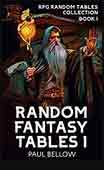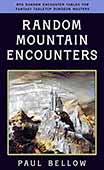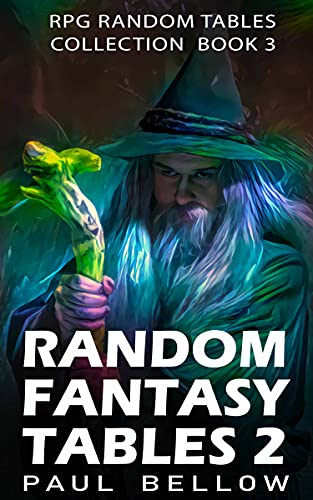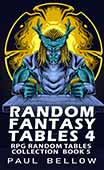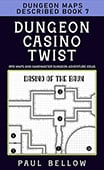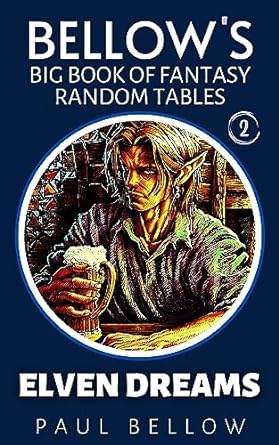Downtime: the elusive narrative air between the clangor of swords and the hush of eldritch forests. Too often, Dungeon Masters and players alike confine their stories to the thunderous rhythm of battles and the press of quests. Yet, hidden in those quieter stretches—days at a bustling market, weeks lost in a smoky tavern, a season watching the rain lacquer city rooftops—lies the actual soil where character arcs germinate, tangle, and bloom. Downtime is not a blank gap in the story; it is the narrative’s breath, letting characters exhale after peril and inhale future ambition.
Every table has faced the question: what do our heroes do between dragons? Downtime scenes are windows for players to gaze inward, reflect on their scars, and decide who they’re becoming. Here, decisions made are not always about who lands the killing blow, but about who pens the apology, who stays up learning a new tongue, who quietly acquires debts, rivals, or regrets. In these moments, players aren’t forced by plot or dice—they steer, they choose, they change.
The magic of downtime is in its flexibility. Some sessions freeze time for mere hours: a night spent sipping secrets in a raucous inn or forging alliances over dice games. Others sprawl across weeks: crafting a magical item, composing a ballad, learning the labyrinthine alleys of a city. Occasionally, downtime swallows a season or more—a year reigning over a reclaimed keep, a winter apprenticing under a mysterious mentor. The length of downtime doesn’t matter; its impact, however, is profound.
What’s too often overlooked is that downtime is not meant to be filler or fast-forward. It is the crucible where emotional growth, personal challenge, and even legendary destinies are forged. Here, trauma is processed, ambitions are mapped, and forgotten kin are rediscovered. Every downtime scene, properly handled, becomes a rich, character-focused drama that swells with potential energy, ready to explode into the next chapter of high adventure.
This article is your guide to using downtime not as a throwaway pause, but as fertile territory for character arcs and worldbuilding. We’ll show Dungeon Masters how to weave downtime into campaigns as purposeful narrative gold, offering opportunities for transformation, conflict, and even new adventures born from the soil of introspection and ambition.
What Makes Downtime So Powerful
Downtime is the rare stretch in any TTRPG where players are free to pilot their fates. Unlike the carousel of encounter-driven storytelling—where initiative is rolled, and choices are winnowed by danger—downtime feels unscripted, non-linear, and bursting with possibility. The initiative is strictly in the hands of the players, not the dice or DM.
Try my AI Tabletop RPG generators...and an extensive library of content!
It is a space for characters to process trauma, synthesize recent triumphs or failures, and interact with the world on their own terms. Whether it’s befriending the oddball artificer in the town square, training dogs for war, or finally penning that unsent letter home, downtime invites autonomy. Here, characters aren’t wielding weapons—they’re wielding agency.
When downtime is structured with intent—with options, prompts, and real consequences—it deepens player investment. Ownership of character arc emerges not just from what happens to heroes, but from what they choose to pursue when nobody is watching and the world isn’t demanding action. This ownership is electrifying; it transforms players from audience members to co-authors, and it ensures they see their story in every corner of the world.
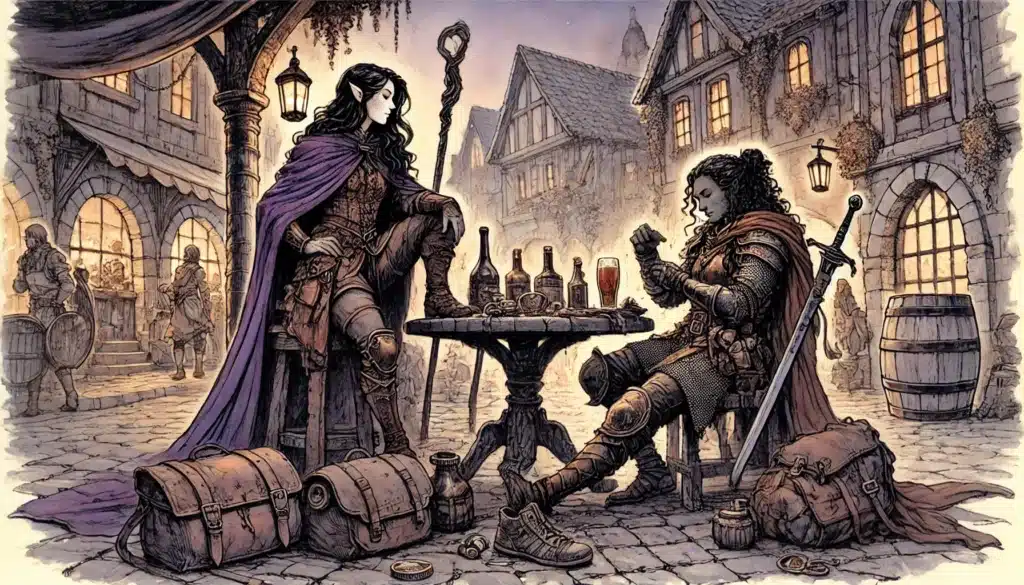
Structuring Downtime Within a Campaign
Integrating downtime takes finesse. The trick is to thread it into the campaign without derailing narrative momentum. The best moments to lean into downtime often follow emotional or physical climax: after harrowing dungeon crawls, major level-ups, the close of narrative arcs, or seismic political shifts. These are moments when characters—and players—need room to breathe, recalibrate, and redirect their energies.
Consider framing downtime as “downtime weeks”—either mid-session (taking a break after major events) or as narrative timeskips between sessions. Seasonal breaks are evocative: a winter snowed into the citadel, a languid autumn spent surveying new lands, or boiling city months where the streets teem with intrigue and fever. Even a single evening, handled well, can become a microcosm of character growth.
⚔️ Fantasy RPG Random Tables Books
Make life as a Gamemaster easier…
If you play Dungeons & Dragons, Pathfinder, or other fantasy RPGs, this
RPG random tables series
is packed with encounters, NPCs, treasure, and more. Available in eBook or print—either way, you’ll have a wealth of adventure ideas at your fingertips.
Don’t be afraid to structure downtime as interludes or vignettes, each with a beginning, middle, and end. Let scenes unfold with their own gentle arcs: a problem to solve, an NPC to convince, an internal struggle to resolve, or a lingering question to consider. These vignettes can be table-wide or spotlight, inviting each player to step forward and leap into the narrative emptiness with something deeply personal.
If you need inspiration, frame downtime periods with evocative hooks:
- Winter in the capital city during a festival of lights
- The week after a harrowing dungeon crawl, celebrated in a rowdy tavern
- A month living under assumed identities in enemy lands
- Years spent restoring a ruined keep on the border
- A trade season between mercenary contracts
- Time locked in a mage’s library after a failed experiment
- A six-month jump as the city rebuilds after a siege
- An isolated retreat prescribed by a healer’s orders
- Training under a renowned swordmaster in a far-off monastery
- Overseeing the expansion of a guildhall in a bustling market district
- Policing a border province during tense political negotiations
- A pilgrim’s journey to a distant holy site
- Recovery and reflection after lost allies are laid to rest
- A summer in the wilds mapping unknown territory
- An undercover stay in the court of a rival noble
- Administering (or escaping!) the territory you just inherited
Downtime doesn’t need to be DM-driven. Prepare a handful of prompts or scenes based on campaign context and the characters’ pasts, but always leave slots for player-generated suggestions. Ask open-ended questions at the table, invite players to pitch what their heroes do, and let them surprise you with ambitions you never anticipated.
With the right structure, downtime shifts from a quick montage to a tapestry of drama, introspection, and inevitable consequences—setting the stage for not only future quests but entirely new legends.

Roleplay Prompts That Inspire Arc Growth
Downtime’s true magic flickers to life when the right prompts set the scene. Targeted, open-ended questions guide players to explore their character’s inner life, connect with others, and push their own arcs forward. These aren’t mere “what do you do?” queries—they’re invitations to dive deeper.
Begin a downtime session (or interlude) with a handful of roleplay prompts. Print them out as handouts, slip them into secret DM-to-player notes, or use them as icy session openers or warm closing moments. The right question reverberates, nudging a player to begin seeing new sides of their character and the world around them.
Encourage characters to reflect on their motives and unravel the threads of relationships that may have tangled unnoticed. What have they sacrificed for their goals? Who are they drawn to? What ghosts still haunt their sleep? Push for meaningful choices—downtime is where those seeds are planted, watered, and, with luck, bloom.
Here are some evocative downtime roleplay prompts:
- What personal secret are you almost ready to reveal?
- Who do you send a letter to, and what does it say?
- What do you fear you’ve become since leaving home?
- Who from your past returns unexpectedly, and what do they want?
- What memento do you keep hidden, and why can’t you let it go?
- Which NPC do you confide in tonight, and about what?
- What new habit have you picked up (good or bad)?
- When you look in the mirror, what surprises you most?
- Who do you visit to make amends, and what do you say?
- What dream has started haunting you?
- What rumor about yourself is spreading around town?
- Which tradition from your homeland do you miss most?
- What promise did you quietly break?
- What skill are you desperate to learn, and why?
- Who inspires you to change, and how do you act on that?
- What old grudge or friendship is rekindled?
- What temptation do you resist—or fail to resist?
- Who notices you in a way that unsettles or excites you?
Give your players moments alone with these questions—allow them to process in private, jot down answers, or bring the response to their next scene. Let each player have spotlight time if they want it, using their answers to fuel one-on-one vignettes that can run parallel to the group’s narrative.
Remember: not every prompt will land with every character, but the options generate sparks. What began as an idle letter could become a plot, what started as a haunted dream might become a whole quest. The story lives in these quiet, unguarded intervals between heroics.
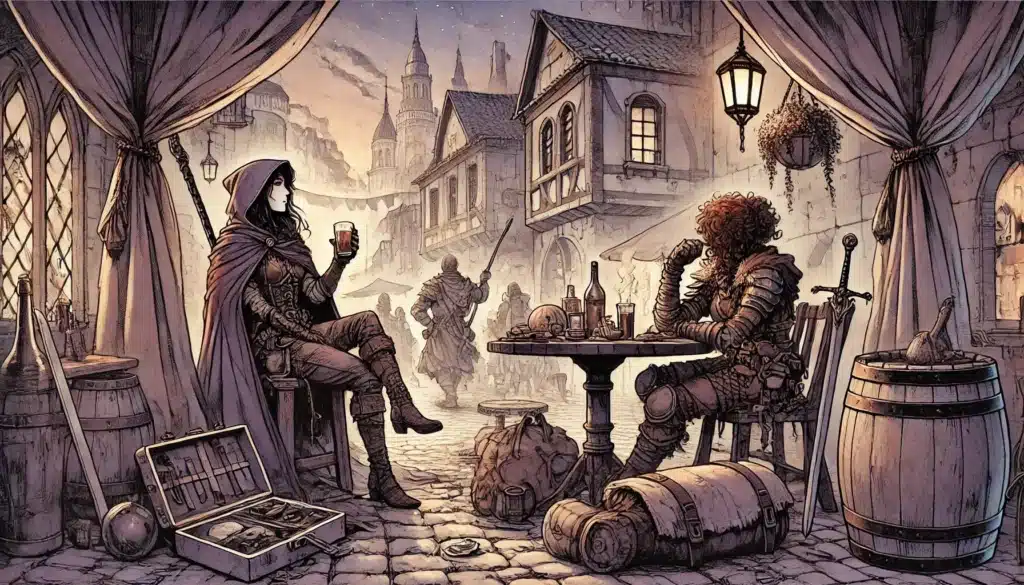
Downtime That Sparks New Storylines
The beauty of downtime is that it’s never truly idle. What begins as a quiet scene—researching forbidden magic, haggling for horses, or trying to win over a jaded local—can spiral into a story before anyone realizes it. DMs who keep a keen ear out for hooks in downtime actions can transform the mundane into mythic.
Picture this: a character opens a potion business for a little extra cash. Within a fortnight, the local apothecaries’ guild is at their throat, and mysterious break-ins plague the shop. A meditative sojourn to commune with a god draws not just insight but the sharply focused attention of a celestial rival. Hours spent poring over old maps in the city library reveal coded messages that nobody’s deciphered in generations. Downtime is a springboard—and every leap can cause ripples, or whole new waves.
Encourage player ambitions, but remind them that every action in downtime—however innocent—can have consequences, both for their character and for the world. Sometimes, these seeds grow into side quests; sometimes they explode into major arcs or campaign-defining rivalries.
⚔️ Fantasy RPG Random Tables Books
Make life as a Gamemaster easier…
If you play Dungeons & Dragons, Pathfinder, or other fantasy RPGs, this
RPG random tables series
is packed with encounters, NPCs, treasure, and more. Available in eBook or print—either way, you’ll have a wealth of adventure ideas at your fingertips.
Let these downtime ideas inspire your next story hook:
- Buying forbidden tomes draws the Eye of a warlock cabal.
- Sponsoring an orphan leads to a dangerous inheritance.
- Your love interest is being watched by a powerful noble.
- Running a gambling racket lands you in debt to a crime boss.
- Commissioning a mysterious artifact attracts cult attention.
- Researching ancestral bloodlines uncovers a family curse.
- Training a local militia angers the city guard.
- Forming an explorers’ league ruffles bureaucratic feathers.
- Hosting a festival leads to unexpected magical mishaps.
- Volunteering at a temple sparks a theological controversy.
- Donating to a cause triggers blackmail from a rival.
- A friend’s wedding ends in a magical disaster.
- Restoring a derelict property awakens a sleeping spirit.
- Negotiating a peace deal sets off an assassination plot.
- Crafting an enchanted weapon draws a jealous rival’s challenge.
- A local artist’s portrait reveals a sinister prophecy.
Track these threads as you would any quest. Let the world react to what players choose to do in downtime: relationships deepen, enemies grow more subtle, and the line between downtime and main adventure blurs.
Crucially, keep a campaign notebook where you log downtime outcomes—a ledger of promises made, secrets revealed, alliances brokered, and grudges sworn. Reincorporate these threads regularly, elevating downtime from a side activity to a living, breathing engine for ongoing stories.
Emotional Weight and Character Depth
No clashing sword nor eldritch horror will ever pull raw emotion from a hero the way a silent candlelit vigil, a desperate written confession, or a midnight talk with a friend can. Downtime is an invitation for players—and by extension, their characters—to experience feelings impossible to access in the thick of battle.
Contentment, regret, longing, and nostalgia blossom in downtime scenes. Who mourns the mentor left behind? Who grows homesick as blizzards blanket strange streets? Who kindles a forbidden romance, or wrestles with the legacy their choices have already shaped?
Use pacing, sensory details, and even table music to create emotional resonance. Linger in the silence of a cathedral’s nave, the nervous heat of a first dance, the choked sorrow in a newly wakened ancestor’s voice. Ask players not only what their character does, but how it feels—the joy, the fear, the guilt beginning to unfurl.
Some emotionally focused downtime scenes:
- Lighting a candle for every ally lost.
- Teaching a child your craft, remembering your own teacher.
- Waking from a nightmare about the future.
- Telling the truth to someone you’ve lied to all campaign.
- Standing vigil at a wounded friend’s bedside.
- Writing a last will after a close call.
- Returning to the ruins of your childhood home.
- Confessing feelings to a love interest—accepted or not.
- Reuniting with an estranged sibling.
- Making a sacrifice for another’s happiness (with or without their knowledge).
- Receiving a letter with devastating or joyous news.
- Hiding away an object you can’t bear to destroy.
- Planting a tree in memory of someone gone.
- Keeping a promise against incredible odds.
- Watching the sun rise, alone, after a moral crisis.
Offer players these scenes, but never demand emotional displays. Let them process, react, and recover at their own pace. Use NPCs to quietly note changes: a mentor’s gentle surprise, a rival’s mocking disdain, a friend’s silent support. Emotional stakes are only as real as the world’s willingness to notice and remember them.
In these intervals, character depth emerges not from what threats are faced, but from how they’re felt, remembered, and, ultimately, transformed by the passage of time.
Using Mechanics to Support Narrative Downtime
Downtime isn’t just roleplay and reflection—it offers rich opportunities to let mechanics drive drama. Done artfully, skills, tools, and rolls become narrative tension: success tastes sweeter, failure stings sharper, and complications create new story beats.
Start with the DMG and Xanathar’s downtime activities—crafting, research, training, running a business, carousing—but resist treating them as mere checklists. Every roll should be a living crossroads: what risk are you taking with your gold, health, or reputation? How do complications ripple outward? Decisions around money, time, and trust become true moral dilemmas, not just “make a check and move on.”
Skill checks can be the fulcrum upon which entire scenes turn. Maybe a failed persuasion roll during training sour a mentor’s mood; perhaps a complication when brewing potions brings a rival sniffing near. Moments like these create juicy drama, not empty numbers.
Finding the balance—mechanics to structure, narrative to inspire—calls for flexibility. Consider incorporating the following as you plan your downtime scenes:
| Downtime Activity | Game Mechanic | Narrative Hook |
|---|---|---|
| Train under a Swordmaster | Ability/Skill check for proficiency gain | The trainer has a cursed blade they won’t speak of |
| Research forgotten lore | Intelligence (Investigation) checks | A forbidden prophecy is uncovered |
| Brew rare potions | Tool Proficiency + Resource cost | A rival sabotages a batch |
| Craft a magic item | Long downtime + gold + Arcana checks | The reagents attract planar attention |
| Run a business | Charisma (Persuasion) + gold investments | A criminal syndicate demands a cut |
| Write a memoir | Wisdom/Charisma roll | Scandalous family secrets come to light |
| Train an animal companion | Animal Handling checks | The beast bonds—or rebels—unexpectedly |
| Master new spells | Intelligence + Spellbook costs | A renowned arcanist takes notice |
| Resolve a legal dispute | Insight & Persuasion contest | A corrupt magistrate threatens blackmail |
| Forge an alliance | Series of skill checks over weeks | Competing factions try to sabotage talks |
| Perform at a festival | Performance checks | The song reveals more than intended |
| Learn a new language | Intelligence checks over months | The language holds political significance |
Don’t be afraid to tweak mechanics for speed—distill lengthy tables, roll in batches, or narrate all but key moments. Mechanically supported downtime is glue for narrative, never a replacement. When two rules clash, always let the story have the last word.
By adjusting or simplifying rules on the fly, you empower the story to keep flowing, turning downtime activities into legend rather than logistics. Let mechanics illuminate tension and consequence, but never let them choke out emotional pacing.
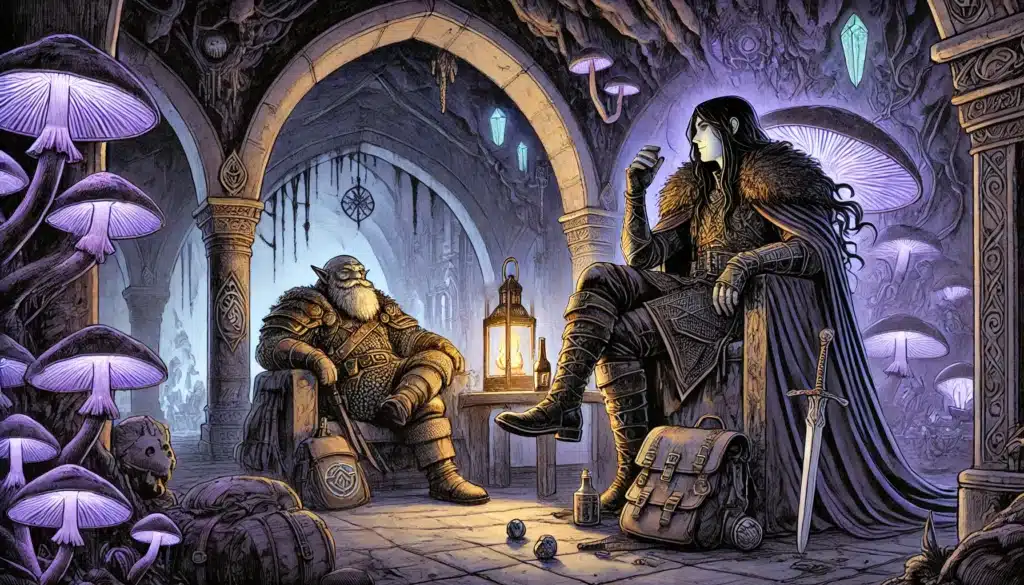
Downtime Between Players: Interpersonal Growth
Downtime doesn’t just run between individual heroes and the world; it pulses most vividly between party members themselves. The space between quests is fertile ground for friendships, mentorships, grudges, and even hilarious rivalries to emerge organically.
Encourage players to pair off or break into small groups during downtime. Maybe the barbarian asks the wizard to help craft a rune. The rogue and the bard sneak out for a night on the town, seeing who can steal the juiciest rumor. The taciturn cleric invites the ranger for early-morning prayer walks, sharing fears beneath pre-dawn stars. These are the moments where shared goals crystallize and differences find (or fail to find) resolution.
Short roleplay scenes—ten minutes at the start of a session or woven organically between quests—cement bonds. They also reveal hidden rifts, break open unspoken grudges, or plant the seeds of deep camaraderie. Some of the most memorable party moments come not from saving the world, but from saving each other—emotionally, morally, or literally.
For inspiration, here are party-focused downtime pairing ideas:
- Forge an item together (and tell the story behind its design)
- Write a song ballad about a recent battle
- Exchange dreams or nightmares over a midnight meal
- One trains while the other spars, challenges, or even coaches
- Share family stories by firelight
- Re-enact a childhood ritual from one character’s homeland
- Confide deepest fears (or invent wild backstories for laughs)
- Share and compare personal goals for the future
- Cook or hunt for the party during travel downtime
- Try to teach each other a skill (with comic or heartfelt results)
- Bet on who can outwit or befriend a local NPC
- Plan a prank on a fellow party member (and then deal with the fallout)
- Care for another party member during illness or injury
- Pray, meditate, or perform a cultural ceremony with someone else
- Run a business or craft project as co-owners
- Roleplay debating a major decision that divides the group
Encourage players to step out of their usual pairs—barbarian and bard, rogue and paladin, wizard and fighter. Allow the quietest members to shine, and give space for subplots, inside jokes, and even rivalries to heat or cool.
These scenes resolve tensions, deepen relationships, and spark connections that ripple through every future adventure. Sometimes, a shared meal by torchlight lingers in the memory far longer than even the fiercest dragon’s roar.
Downtime as a Player-Led Sandbox
A campaign truly comes alive when downtime becomes a crucible for wild, player-led ambition. Let your heroes found guilds, start families, learn trades, or create works of art that live on in the setting long after they’re gone. In these sandbox sessions, consequences matter—the world flexes and shifts around their choices.
Try my AI Tabletop RPG generators...and an extensive library of content!
Encourage players to dream big, but also make clear: every action changes the landscape. Run with their wild ideas and return unexpected repercussions, both good and bad. Let them pursue dreams that color the world, tie up NPCs, and generate entirely new obligations.
Here are sample outcomes reflecting the ripple effects of player-led downtime:
| Player Downtime Goal | Resulting World Change | NPC Reaction |
|---|---|---|
| Start a mercenary band | Local crime rates drop | Thieves’ Guild places a bounty |
| Write and perform a controversial play | Nobles feud, warring over public opinion | A patron demands a rewrite |
| Open a bakery in a poor district | Neighborhood prospers, new jobs created | Rival bakers spread rumors |
| Marry into a noble family | Political alliances shift | Spurned former suitors plot revenge |
| Train local street urchins | City guard standards improve | Corrupt watch captain tries to arrest PC |
| Establish a magical academy | Surge in new spellcasters | Church elders voice concern |
| Build a shrine to a small deity | The god’s cult gains popularity | Rival faiths protest |
| Compose a national anthem | Unites diverse provinces | Bards compete to reinterpret it |
| Craft a legendary artifact | Attracts adventurers from afar | Artificer’s guild tries to poach the crafter |
| Publish a scandalous history book | Topples a corrupt official | Censors demand the book destroyed |
Even the smallest player choices—like owning a shop or fostering an NPC apprentice—can echo across the city, or even the continent, as word spreads, rivalries form, and legends unfurl.
Remind DMs: never dismiss the “small stuff.” That trinket shop, that incremental law change, that novice-turned-protégé—these details accumulate into setting-defining lore. The world feels alive because the players can nudge it, shape it, and leave their fingerprints everywhere.
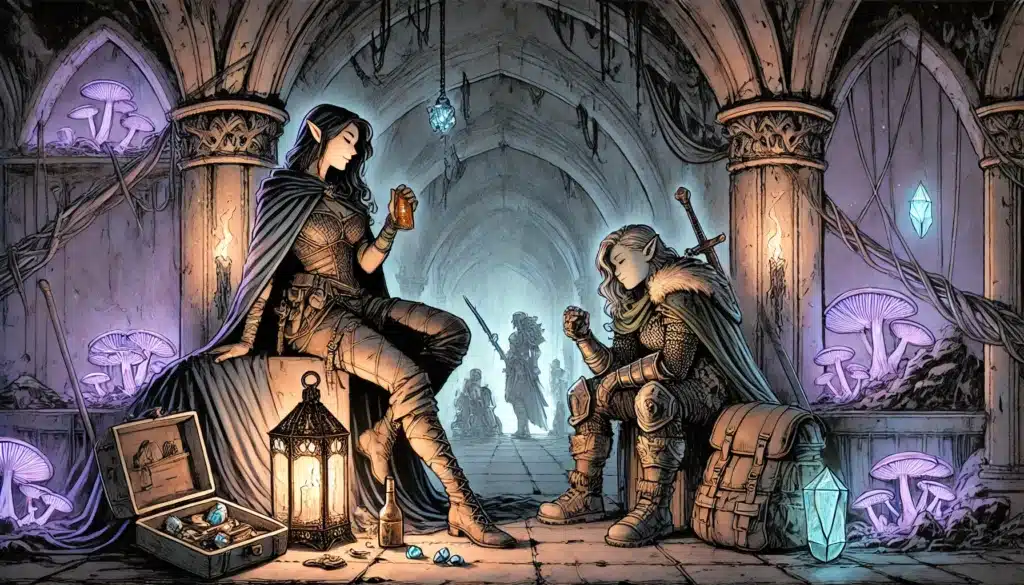
Final Thoughts on Downtime as Storytelling Gold
Downtime in D&D isn’t the pause between stories—it’s where the real stories find their shape. Here, arcs bend, relationships knot or fray, and ambitions root deep beneath the surface. It’s the heartwood of narrative, allowing players to see their legends not as a constant sprint, but as a marathon with spaces to breathe, reflect, and dream.
Let downtime be narrative scaffolding—the quieter framework holding up every heroic tale. Use its rhythms for emotional resonance: grief that lingers, love that quietly grows, regret that stabs when least expected. Blend mechanics, prompts, interludes, and consequences. Make each downtime scene matter, a stepping stone from who your characters were to who they might yet become.
⚔️ Fantasy RPG Random Tables Books
Make life as a Gamemaster easier…
If you play Dungeons & Dragons, Pathfinder, or other fantasy RPGs, this
RPG random tables series
is packed with encounters, NPCs, treasure, and more. Available in eBook or print—either way, you’ll have a wealth of adventure ideas at your fingertips.
When you honor downtime, you honor the story’s potential: space for transformation, for heartbreak, for discovery. Daring quests and bloody battles may forge heroes, but only silence, sanctuary, and reflection can shape them. That’s where true legends birth themselves—quietly, persistently, in moments between the storm.
The table is yours. Offer both fire and quiet: moments to conquer, and moments to simply be. Watch as players step forward with new scars, new determination, and new dreams, ready for whatever adventure you place before them next.
Because in D&D, as in life, it’s not just the roar that shapes you, but also, always, the hush that follows. Give your campaign both, and your stories will never be forgotten.


